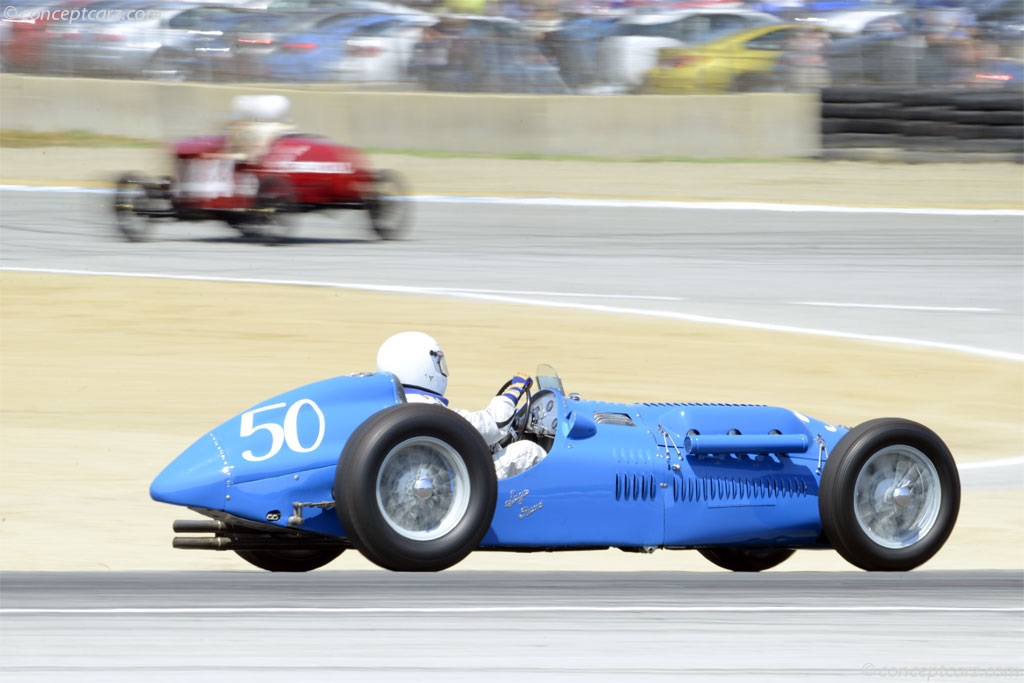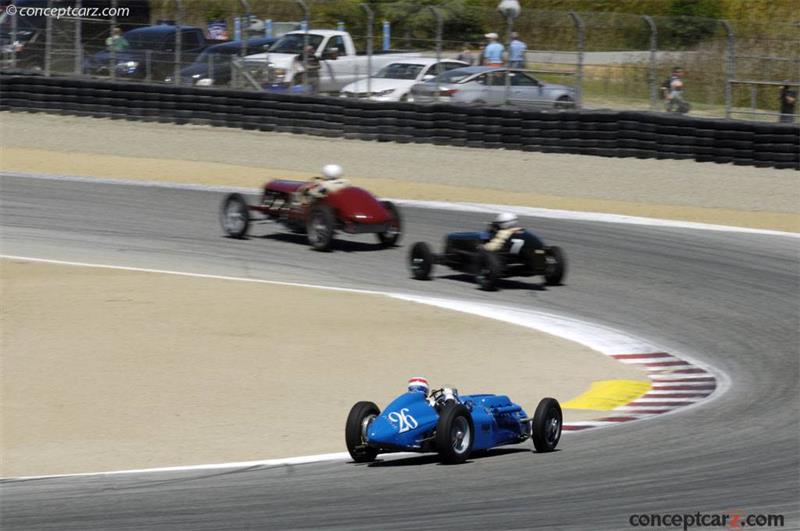1950 Talbot-Lago T-26C Grand Prix Navigation
In motor racing, when it comes to the subject of a driver's legacy, being one of the 'great ones' is usually synonymous with victories and championships. Yet, there is another legacy, not measured in personal victories or championships, but, in the collective preparation of other racers and future generations of racing drivers. Louis Rosier was a very good race driver; victorious and a champion. But the depth of his legacy, it could be argued, lay in the number of other careers he helped foster. 
Monoposto
Chassis #: 110052
View info and history Louis Rosier was born November 5th, 1905, in Chapdes-Beaufort, France. Louis's father was a wine merchant. As Louis grew older he became an apprentice in an automobile garage. On the side, he began to race motorcycles, mostly in hillclimbing events. Soon after, Rosier opened up his own garage. Thus began his love affair with Renault and Talbot. Louis proved to be an entrepreneur straight-away as he not only opened his own garage, but he also started his own transport company in Clermont-Ferrand. This small city would always hold a special place in Louis' heart and would prove to provide yet another entrepreneurial idea for Rosier later in life. Toward the end of the 1930s, when Rosier was in his early 20s, he started to take motor racing more seriously. Louis competed in more hillclimbs, and even tried his hand in the 1938 24 Hours of Le Mans. Rosier co-drove a Talbot T150SS Coupe with fellow Frenchman Robert Huguet for the Italian Luigi Chinetti team. Of course, to drive a Talbot for the famously successful Chinetti was a real honor. Unfortunately, Rosier did not experience the same success at Le Mans Chinetti did. The Talbot failed to finish the race after lasting only 81 laps. Being so close to the outbreak of World War II, Rosier's racing career would go on hold, but he did not go into hiding…well metaphorically. During the war, Rosier worked with the French Resistance. The war years were dangerous times and Rosier lived with that threat each and every day, and was not immune to the effects of those dangers. Rosier was under threat of capture by the Germans but was able to escape. Unfortunately, Rosier's wife and daughter were taken by the Germans instead. Thankfully, Rosier was able to find them at war's end after following them to Germany to try and locate them.
Monoposto
Chassis #: 110052
View info and history With the end of the war, Rosier was able to go back to his regular job and passion as a racing driver. Perhaps it was the maturity and fearlessness birthed through war experience, but whatever it was, Rosier stepped into a whole new level of competitiveness upon his return to racing. Almost immediately, Louis began to not only do well in races, but actually win them. In 1947, at the Belgian Grand Prix, the Grand Prix de Reims and the Grand Prix de Nice, Rosier was able to finish 6th, gaining one point for each in the unofficial world championship at that time. Sandwiched in between those races, Louis took home his first win at the Albi Grand Prix, beating Raymond Sommer. At the last race in France during the 1947 grand prix season, Rosier showed good form yet again. At the Grand Prix de l'Automobile Club de France in Lyon-Parilly, Louis cam home in 4th place one lap behind race winner Louis Chiron. This result, along with his other good showings, set Rosier up for strong successful years to come. In 1947, Rosier finished the season and the unofficial championship in 6th place. In 1948, Rosier would build on the previous year's good result and propelled himself three more places higher into 3rd. Rosier earned one win toward the end of the year in October, at the Grand Prix du Salon. This victory, and many other good results kept him up toward the top of the driver's championship. At the Grand Prix de Pau in France, the first race of that year, Louis was able to finish 4th, earning him 3 points toward the year's championship. Rosier did not race again until the next race on French soil, the Grand Prix de L'A.C.F. At this race Rosier was able to secure only 1 point with his 6th place finish. But this was another point toward the 1948 championship. Rosier competed at the next race in Torino, Italy, the Gran Premio d'Italia. The presence of Villoresi, Parnell, Sommer and Ascari meant finishing in the points would be no easy affair. Despite their presence, Louis showed his true prowess in his Talbot-Lago T26C (see Talbot-Lago T26C article) coming home once again in 6th but earning yet another point. 
Monoposto
Chassis #: 110052
View info and historyRosier then ventured over to England for the next round, the British Grand Prix at Silverstone, which took place in October of that year. Here, Rosier matched his best result of the season with a second 4th place finish, and yet, another 3 points toward that year's championship. Confidence was undoubtedly riding high for Rosier as he ventured back to home soil for the next race on the 1948 championship calendar, the Grand Prix du Salon. In the end, Rosier beat out the likes or Parnell, Bira and Chinetti (the man for whom Rosier drove for in his first 24 Hours of Le Mans back in 1938) and took his first win of the season, earning him 9 more points for his championship tally.
The last race of the '48 season took place at Spain's Gran Premio de Pena Rhin, in Barcelona. In Barcelona Rosier had to compete, one more time, against drivers like Bira, Parnell, Ascari, and Villoresi. But Rosier was truly coming into his own as a potent racing driver. Despite not winning the race, the Frenchman came home in 4th, again earning him another 3 points. In the end, Rosier finished the 1948 championship in 3rd with 20 points, some 15 behind championship winner Jean-Pierre Wimille.In 1949, the chances of Rosier improving upon his 3rd place finish in the championship would be much tougher. With the presence now of Fangio, Farina and the incredibly potent Maserati 4CLT/48, the competition for the championship would be much tougher and tighter. Yet, Rosier proved to be up to the task. The efficiency of the Talbot-Lago's fuel burn, compared to that of the thirsty Maserati, undoubtedly help. The fuel efficiency of the normally-aspirated Talbot-Lago kept it in races though it was outpaced by the performance of the supercharged Alfa Romeos and Maserati.
Monoposto
Chassis #: 110052
View info and historyRosier would again score a victory at the Grand Prix of Belgium at Spa-Francorchamps, but would also score a 3rd, a 6th and a 4th, respectively. Along with the win at Spa, Rosier amassed a total of 17 points and finished the season 8th behind most all of the well-known big names of grand prix racing. Truly, Rosier did belong amongst the company of greats. This competition of man and machinery set the stage for the coming of Formula One's existence the following year, and Rosier was not about to miss out. 1950 was a busy and rather successful year for Rosier, and it proved to firmly cement Rosier's reputation as a competitive and talented driver. In 1949, Rosier had incredible duels with drivers like Fangio and Villoresi. The battle resumed in earnest at the Pau Grand Prix in April. Once again Rosier performed well, proving to be one of the top drivers. And, yet again, Rosier came in 3rd behind Fangio and Villoresi.The promising start didn't make it to Louis' next race at the Grand Prix de Paris at the end of April of that year. Rosier's race did not go well. In fact, the race did not go well for many of the competitors of the race as there were only three finishers. Unfortunately, Rosier was not one of those who finished the race.
At the first event of the new world championship series, Rosier was determined to use his talent to achieve a good result. He entered the first event at Silverstone with his 4.5 liter Talbot-Lago T26 under his own team name of Ecurie Rosier. Rosier qualified a very respectable 9th. This meant Louis would start the race from the 3rd row of the grid. Rosier would build upon his confidence gained from qualifying. In the race Rosier was fast but steady in his T26. Louis drove a splendid race and finished 5th, turning around from the failure to finish he suffered at the GP de Paris only a couple of weeks prior. The 5th place finish meant Rosier had scored 2 points toward the driver's championship.
Monoposto
Chassis #: 110052
View info and historyThere wasn't much time for Rosier to really enjoy the result at the British Grand Prix, however, as he ventured down to Monte Carlo for the Monaco Grand Prix a week later. Rosier qualified 10th, 7.5+ seconds behind pole-sitter Fangio. The truly unfortunate part of the Monaco Grand Prix for many, including Rosier, was the first-lap incident that took out many of the competitors. Like eight other drivers, Louis' race was done without having even finished one lap. Worse yet, this meant Rosier scored no points to go toward his championship tally. This was something Louis, undoubtedly, was keen to rectify. Louis would find some sense of vindication over the course of the next few races in which he would compete. The summer months kicked of with a bang. There have been a few father/son driver combinations who have competed in the 24 hours of Le Mans throughout its history. However, only one father/son duo has taken the overall victory at the race. That honor would go to Louis and his son Jean-Louis. This victory at the 24 hour event set Rosier up for a strong run through the rest of the racing season.The grand prix venture got back on the right track when the championship headed to Switzerland for the Swiss Grand Prix, held at Bremgarten. Rosier showed up racing the usual straight-six Talbot-Lago people grew accustomed to seeing him in, but this time he arrived with the Automobiles Talbot-Darracq SA team. This was to prove to be a good move in the short-term for Louis. Louis qualified in 10th. His performance in the race, however, was even better as he climbed all the way up to a 3rd place finish and 4 points toward the championship. 
Monoposto
Chassis #: 110052
View info and historyTwo weeks later, Rosier was again behind the wheel of one of Automobiles Talbot-Darracq SA's Talbot-Lagos for the Belgian Grand Prix held on the old course at Spa Francorchamps. Setting a time some 16+ seconds behind pole-sitter Farina, Louis qualified 8th, solidly in the middle of the field. This was not indicative of being off the pace however; a fact proven by the race itself. The Alfas of Fangio and Fagioli proved to be powerhouses. However, Louis was able to out-duel the other Alfa of Farina to finish 3rd. A testament to the overwhelming performance of the Alfa Romeos, despite how thirsty the engine may have been, can be seen by the fact Rosier finished the high-speed course over 2 minutes behind!The next race, the French Grand Prix at Reims, would be Rosier's home grand prix on the world championship calendar and an event full of pride for the Frenchman. A good result at his home grand prix, and at a track he knew rather well, would have given him such confidence going into the final world championship event in Italy, a little over a month later. Rosier qualified rather well in 6th. After 10 laps Rosier's Talbot-Darracq's T26C came to an end with overheating issues. But this is the French Grand Prix in the first ever 'official' world championship series. A Frenchman cannot say, 'die'. And Rosier did no such thing. Fellow Frenchman Charles Pozzi ended up pulling over after only 14 laps and let Rosier take over behind the wheel of his Talbot-Lago for the remainder of the race. Looking into the details it is easy to surmise there wasn't much chance of a podium finish for Rosier, but in the grander scope of things, Rosier and Pozzi were able to finish the race in 6th. Of course, never mind the fact they were the last car running on the track finishing the race some 8 laps down to race winner Fangio.Between the French Grand Prix held in July and the final world championship event held at Monza in Italy in September, Rosier competed in a couple of other non-championship races. 
Monoposto
Chassis #: 110052
View info and historyA couple of weeks after his determined finish in Pozzi's Talbot-Lago, Louis was back with his own Talbot-Lago chassis for the Albi Grand Prix. Louis rolled to another 3rd place finish. Sommer finished 1st in his own Talbot-Lago with Fangio finishing in 2nd less than a second behind in a Maserati 4CLT/48.Without a doubt, Louis desperately wanted to improve upon his number of 3rd place finishes. Yet it was difficult with the presence of the Alfa Romeos and Maserati 4CLTs. The Dutch Grand Prix, at the end of July, proved to be the ticket Louis needed. Despite a number of Ferraris, Maseratis and other Talbot-Lagos, Louis' Talbot-Lago carried him home to a 1st place finish ahead of a trio of Ferraris. Finally, he stood on the top step of the podium. This was a sweet victory for Rosier as he was able to fend off the more powerful Ferraris and Maseratis.
Confidence was riding high as Louis made his way to Italy to take part in another non-championship grand prix, the Pescara Grand Prix, which took place in August of that year. Given the final race of the world championship was only a month away, and the fact the race was held in Italy, Rosier had the Alfa Romeos of Fangio and Fagioli with which to contend. Despite their presence, Louis held his own in his Talbot-Lago. Pescara was a rather fast course and seemingly played into the hands of the performance of the Alfa Romeo 158s. But at almost 16 miles in length, the more fuel-efficient 4.5 liter 6 cylinder engine in the Talbot-Lago was able to keep things close since it didn't need to refuel as often. Rosier used this and his talent to his advantage and was able to split the Alfas of Fangio and Fagioli to come home in 2nd after completing the 16 lap event. This added to Louis' confidence as he headed on to Monza for the Italian Grand Prix, the final event on the world championship calendar.Louis traveled the 360 miles from Pescara to Monza to compete with 26 other drivers in the world championship's final event. Monza's layout for the 1950 season bore similar resemblance to that competed on presently. The only major difference in layout of the track for the 1950 race was the final two turns. Each was much more square in their layout coming off of the 'Rettifilo Centrale' backstretch and around to the front stretch. In fact, the 'Curva di Vedano', as it was known, extended out beyond that of the oval track portion as it turned toward the front stretch.
Monoposto
Chassis #: 110052
View info and historyAmidst a sea of Italian drivers and car manufacturers, Rosier took to the track and qualified 13th, 14+ seconds behind the Argentinean Fangio. Fangio was amidst a sea of his own as he was followed on the grid by no less than six consecutive Italian racers driving either Alfa Romeos or Ferraris. The highest placed chassis besides either an Alfa Romeo, Ferrari or Maserati was Sommer's Talbot-Lago in 8th spot on the grid.In the face of so many drivers, and perhaps superior machines, it would be easy to conclude that a good result would be hard to come by. But those drivers and their machines, first of all, have to finish. Attrition at the Italian Grand Prix was extremely high. The abuse of a year of racing obviously was taking its toll. Yet it did not touch Rosier. Though Louis finished the race some five laps behind winner Farina, he did so in 4th place, which garnered him another 3 points in his championship tally. In the championship of that year the four best results were taken into account. For some, like Fagioli, this made a difference. However, Rosier's four best results of the year earned him a total of 13 points and he ended the first world championship season in 4th place behind the three Alfa Romeo drivers of Farina, Fangio and Fagioli. 
Monoposto
Chassis #: 110052
View info and historyThough the world championship season was over, Louis still had one more race in which he would compete, and that was the Penya Rhin Grand Prix in Spain. Unfortunately, the 1950 race season would not end on a high note for Louis as his grand prix came to an end on the 10th lap of the race. 1950 had a few low points for Rosier, but it had a far greater number of highlights. This would encourage Louis to formally create the Ecurie Rosier team. Louis would continue to drive for other teams at times throughout the remainder of his career, besides his own. However, the formal creation of Ecurie Rosier provided an outlet for up-and-coming drivers to have competitive drives in which to prove and improve their talent.Developing the talent of future drivers, and just the future of racing, was an important focus of Rosier's life. After World War II, Rosier invested in the idea of a race around the area of Clermont-Ferrand. The track's preliminary layout was done, but was put on hold. The track idea was meant to travel through the small towns around the area similar to the way Le Mans is set up. In 1955 a huge disaster struck Le Mans and this halted any event to take place on temporary urban layouts. Despite all of the new safety changes that would have to be implemented the idea for the track moved forward. 
Monoposto
Chassis #: 110052
View info and historyUnfortunately, Rosier would end up not seeing his single greatest effort for the promotion of racing and of future driving talent come to fruition. Rosier died due to injuries he sustained in a crash at the Montlhery track just south of Paris in 1956. When the track Rosier dreamed of and promoted was opened it was given the name 'Circuit de Charade Louis Rosier'. In fact, the circuit's start-finish line is on 'Virage Rosier'Just a glance through France's auto-racing history; its race tracks and champions, its victories and 'firsts', the name 'Rosier' constantly appears. The depth of Louis Rosier' talent as a racing driver is unmistakable. But the depth of his influence, his promotion of autoracing and of future autoracing drivers is so vast it's almost imperceptible, like wind driving the sail. But it's there to see; if one looks. This is the legacy of Louis Rosier. Cloud, Quintin. 'Formula One Homepage of GP Results and History.' www.fortunecity.com/olympia/grange/54/
http://www.fortunecity.com/olympia/grange/54/Jenkins, Richard. 'The World Championship drivers - Where are they now?'. OldRacingCars.com. http://www.oldracingcars.com/driver/Louis_Rosier. Retrieved 2007-07-29. Rosier First In Auto Race, New York Times, June 26, 1950, Page 36. Grand Prix To Villoresi, New York Times, October 3, 1948, Page S10. De Graffenried Annexes Grand Prix Auto Classic, New York Times, May 15, 1949, Page S6.Wikipedia contributors. 'Louis Rosier.' Wikipedia, The Free Encyclopedia. Wikipedia, The Free Encyclopedia, 2 Apr. 2010. Web. 23 Apr. 2010.By Jeremy McMullen

Monoposto
Chassis #: 110052
View info and history

Monoposto
Chassis #: 110052
View info and history
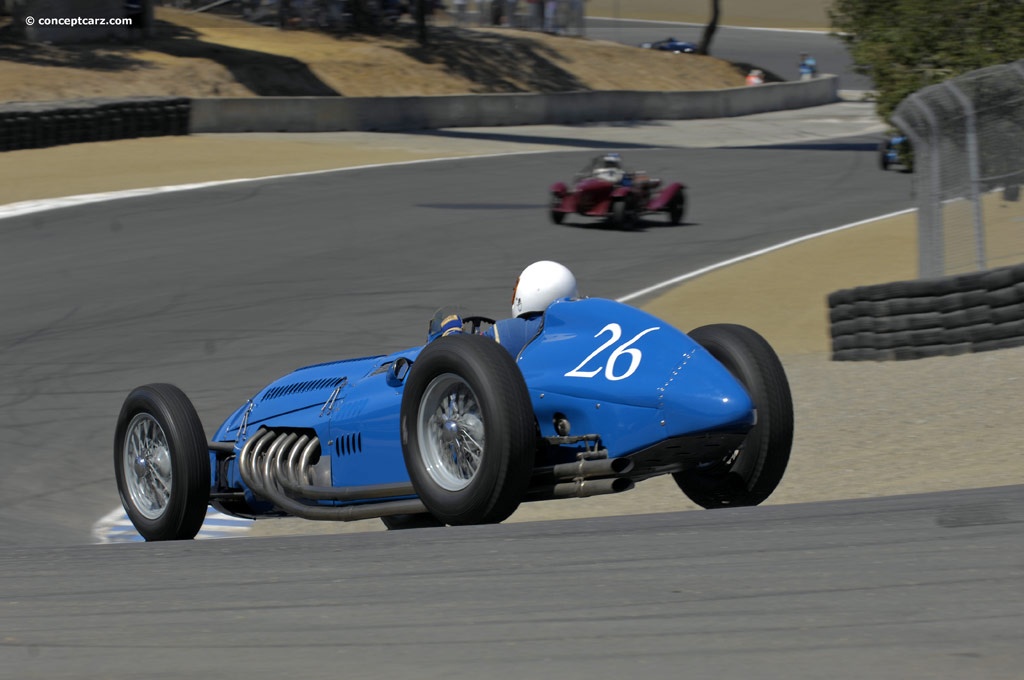
Monoposto
Chassis #: 110052
View info and history
The last race of the '48 season took place at Spain's Gran Premio de Pena Rhin, in Barcelona. In Barcelona Rosier had to compete, one more time, against drivers like Bira, Parnell, Ascari, and Villoresi. But Rosier was truly coming into his own as a potent racing driver. Despite not winning the race, the Frenchman came home in 4th, again earning him another 3 points. In the end, Rosier finished the 1948 championship in 3rd with 20 points, some 15 behind championship winner Jean-Pierre Wimille.In 1949, the chances of Rosier improving upon his 3rd place finish in the championship would be much tougher. With the presence now of Fangio, Farina and the incredibly potent Maserati 4CLT/48, the competition for the championship would be much tougher and tighter. Yet, Rosier proved to be up to the task. The efficiency of the Talbot-Lago's fuel burn, compared to that of the thirsty Maserati, undoubtedly help. The fuel efficiency of the normally-aspirated Talbot-Lago kept it in races though it was outpaced by the performance of the supercharged Alfa Romeos and Maserati.
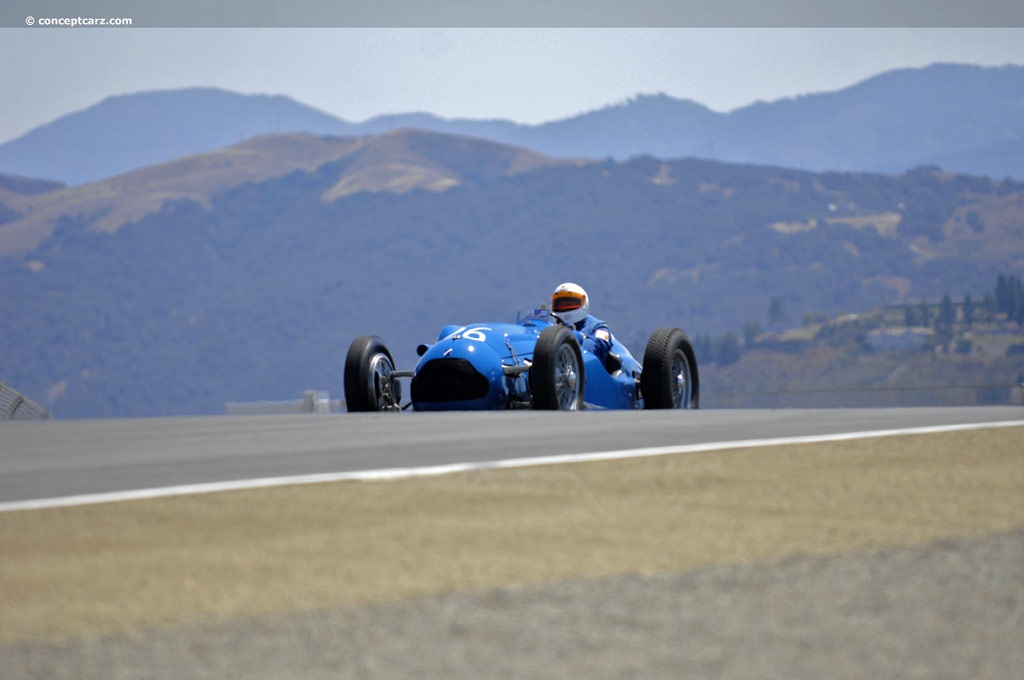
Monoposto
Chassis #: 110052
View info and history
At the first event of the new world championship series, Rosier was determined to use his talent to achieve a good result. He entered the first event at Silverstone with his 4.5 liter Talbot-Lago T26 under his own team name of Ecurie Rosier. Rosier qualified a very respectable 9th. This meant Louis would start the race from the 3rd row of the grid. Rosier would build upon his confidence gained from qualifying. In the race Rosier was fast but steady in his T26. Louis drove a splendid race and finished 5th, turning around from the failure to finish he suffered at the GP de Paris only a couple of weeks prior. The 5th place finish meant Rosier had scored 2 points toward the driver's championship.

Monoposto
Chassis #: 110052
View info and history
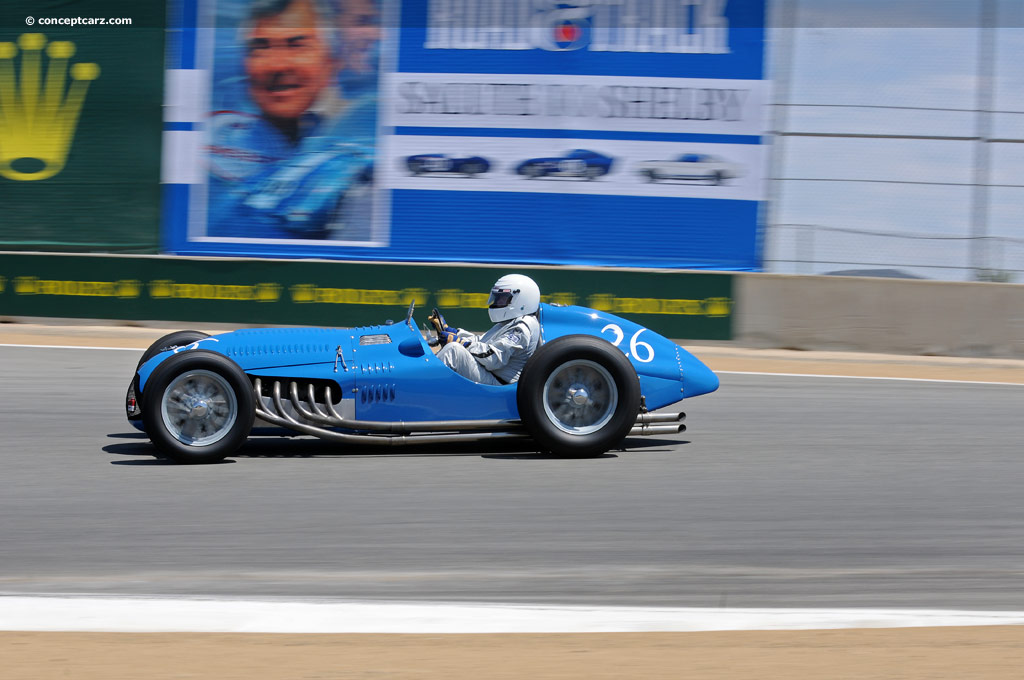
Monoposto
Chassis #: 110052
View info and history

Monoposto
Chassis #: 110052
View info and history
Confidence was riding high as Louis made his way to Italy to take part in another non-championship grand prix, the Pescara Grand Prix, which took place in August of that year. Given the final race of the world championship was only a month away, and the fact the race was held in Italy, Rosier had the Alfa Romeos of Fangio and Fagioli with which to contend. Despite their presence, Louis held his own in his Talbot-Lago. Pescara was a rather fast course and seemingly played into the hands of the performance of the Alfa Romeo 158s. But at almost 16 miles in length, the more fuel-efficient 4.5 liter 6 cylinder engine in the Talbot-Lago was able to keep things close since it didn't need to refuel as often. Rosier used this and his talent to his advantage and was able to split the Alfas of Fangio and Fagioli to come home in 2nd after completing the 16 lap event. This added to Louis' confidence as he headed on to Monza for the Italian Grand Prix, the final event on the world championship calendar.Louis traveled the 360 miles from Pescara to Monza to compete with 26 other drivers in the world championship's final event. Monza's layout for the 1950 season bore similar resemblance to that competed on presently. The only major difference in layout of the track for the 1950 race was the final two turns. Each was much more square in their layout coming off of the 'Rettifilo Centrale' backstretch and around to the front stretch. In fact, the 'Curva di Vedano', as it was known, extended out beyond that of the oval track portion as it turned toward the front stretch.

Monoposto
Chassis #: 110052
View info and history
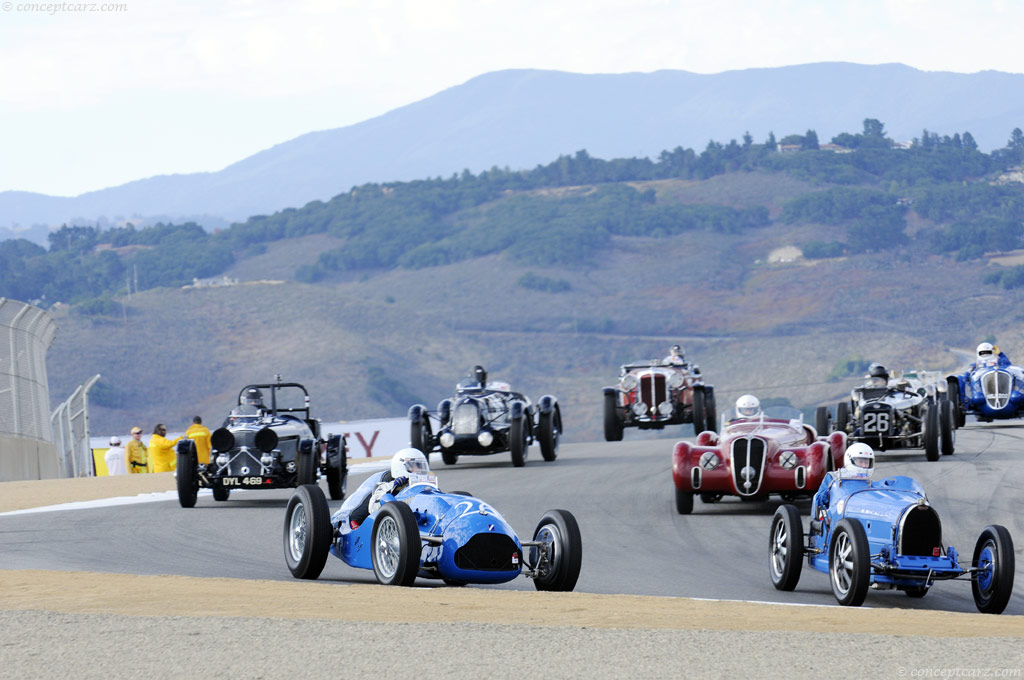
Monoposto
Chassis #: 110052
View info and history
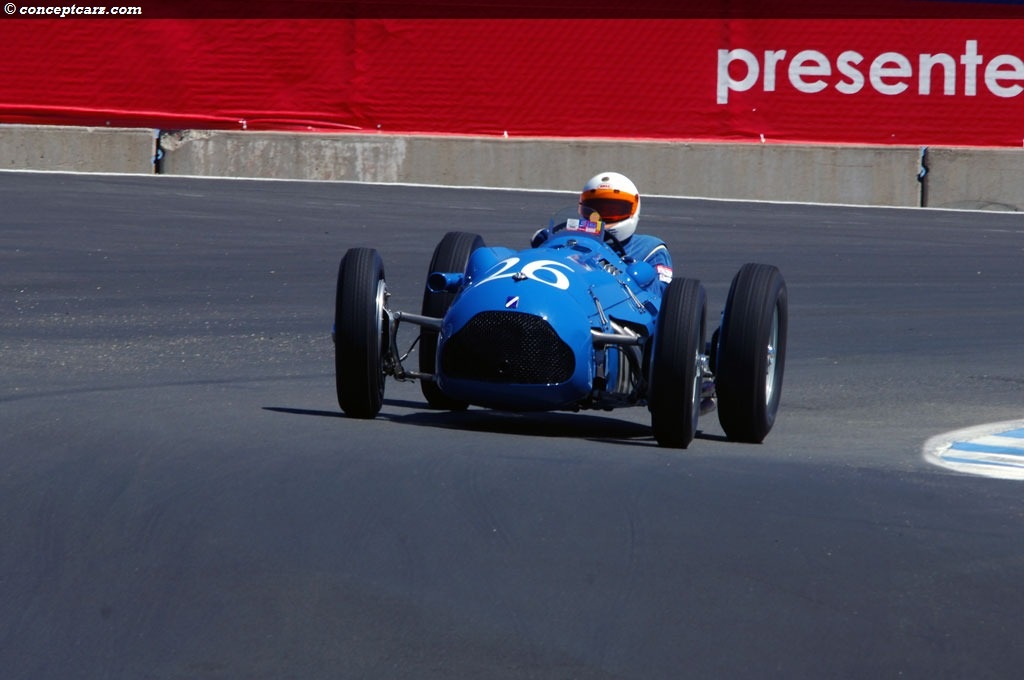
Monoposto
Chassis #: 110052
View info and history
http://www.fortunecity.com/olympia/grange/54/Jenkins, Richard. 'The World Championship drivers - Where are they now?'. OldRacingCars.com. http://www.oldracingcars.com/driver/Louis_Rosier. Retrieved 2007-07-29. Rosier First In Auto Race, New York Times, June 26, 1950, Page 36. Grand Prix To Villoresi, New York Times, October 3, 1948, Page S10. De Graffenried Annexes Grand Prix Auto Classic, New York Times, May 15, 1949, Page S6.Wikipedia contributors. 'Louis Rosier.' Wikipedia, The Free Encyclopedia. Wikipedia, The Free Encyclopedia, 2 Apr. 2010. Web. 23 Apr. 2010.By Jeremy McMullen
Related Reading : Talbot-Lago T26C History
Obscured by the haze of the Alfa Romeo 158s dominance of the first three places in Formula Ones first season was a car from France that made its statement from the other side of the spectrum. While the 158s of the Alfa Romeo SpA team would utilize their superior horsepower and disappear into the distance, the Talbot-Lago exercised a different strategy reminiscent of the tale The Tortoise and the....
Continue Reading >>
Continue Reading >>
Related Reading : Talbot-Lago T-26 History
Anthony Lago had taken over control of the Talbot factory in Suresnes after the merger with Sunbeam and Darracq had collapsed in 1936. By 1937 he had introduced a new line of vehicles, two of which were entered in the grueling 24 Hours of Le Mans. He continued his racing endeavors by moving to single-seat racers, and by 1939, a purpose-built Grand Prix car had been completed. The onset of World War....
Continue Reading >>
Continue Reading >>
Ecurie Belge
In 1950, there were many independent teams that took part in Formula Ones inaugural season. These teams were comprised more of one driver and his own car, more than anything else. Often times, gentlemen of society would form teams to go race. One of those teams was the Ecurie Belge team. Octave John Johnny Claes was born of a Scottish *** and Belgian father and was educated in England.....
Continue Reading >>
Continue Reading >>
- 1950 Talbot-Lago T-26C Grand Prix Menu
- Article
- Image gallery
- Specifications
- Profiles
- Production figures
Talbot-Lago
Similar Vehicles
Similar Automakers
Similarly Sized Vehicles
from 1950
Related Drivers
Related Teams
1950 Talbot-Lago T-26C Grand Prix Vehicle Profiles
Recent Vehicle Additions
Related Automotive News
The Stuff of Legend: Prince Bira, The Mighty Mouse of Siam
In the film Tombstone there is an exchange of dialogue between Wyatt Earp and Doc Holliday. The subject is life. Earp says, All I ever wanted was to live a normal life. To which Holliday responds, There is no normal life, theres just life......

120 years of motor sport at Mercedes-Benz take centre stage at the Goodwood Festival of Speed 2014
Addicted to Winning at this years Goodwood Festival of Speed, Mercedes-Benz looks back on some fascinating racing victories of the last 120 years
The unique motor sport heritage of the Mercedes-Benz brand is being celebrated with an exclusive i...

80 years ago: victory by the Mercedes-Benz W 25 in the International Eifel Race gave birth to the legend of the Silver Arrows
The silver-coloured body of the W 25 gave this nickname to the racing cars from Mercedes-Benz
Successful new development by Mercedes-Benz for the750-kilogram racing formula
Manfred von Brauchitsch drove the W 25 to victory and established a new tr...

Techno Classica 2014: more than 30 racing cars to celebrate 120 years of Mercedes-Benz motor racing history
Cars that were the heroes of magical moments put their stamp on this high-powered, most comprehensive show presentation
With more than 30 vehicles, Mercedes-Benz Classic presents motor racing history in all its unique breadth and depth
120 years o...

1954 24 Hours of Le Mans: A French Bull Runs to Victory at Le Mans
Everything needs to be right amongst drivers competing for victory in the 24 Hours of Le Mans. Not only do they need to share the car over the course of a whole day but their driving styles must compliment each other. In the case of the 1954 24 Hours...
